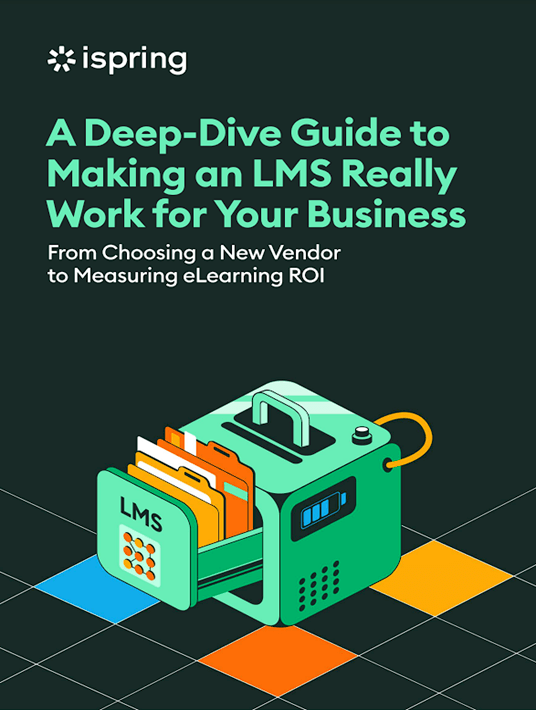
How To Switch LMS Providers
To stay competitive and meet evolving training needs, it’s crucial to know when and how to make a smart switch to a new LMS vendor. Read on to discover how to choose a new training platform provider and migrate successfully.

eBook Release
A Deep-Dive Guide To Making An LMS Really Work For Your Business
Whether you’re new to LMSs or want to get more out of your current platform, this guide will help you make your investment worthwhile.
Why Change Your LMS Vendor?
Here’s a list of common reasons to switch LMS providers:
- Inadequate features. The current LMS lacks the functionalities or capabilities that your organization needs.
- Poor user experience. Users find the system difficult to navigate, leading to low engagement and satisfaction.
- High costs. The costs associated with the current LMS are too high relative to its benefits.
- Lack of support. Inadequate customer service or technical support from the LMS provider.
- Scalability issues. The current LMS cannot scale effectively to meet the growing needs of your organization.
- Integration problems. Difficulty integrating the LMS with other essential systems and tools used by your organization.
- Outdated platform. The LMS is based on outdated technology that does not support modern learning methods and tools.
| Expert Insight
There’s one more reason that’s somewhat trickier: a change in your eLearning tasks and practices. For example, you might now require mobile learning capabilities to support remote employees, or you might need more robust analytics to track learner progress more effectively. Before deciding to switch LMS providers, consider whether you really need a new LMS or if you should simply review and adjust your eLearning strategy to better align with your current needs. Besides, some eLearning providers, like iSpring, are open to adding custom LMS capabilities based on customer requests. See if you can ask your vendor to add a new feature that meets your evolving requirements.
Michael Keller |
LMS Migration: The 5 Essential Steps
If you’re set on switching your LMS provider, follow this simple swap protocol.
Step 1: Update Your eLearning Goals
Take the time to update and refine your eLearning goals to reflect any changes in your business objectives and training needs since implementing your current system. Assess what you now aim to achieve with your training programs, whether it’s enhanced performance tracking, better user engagement, or improved compliance monitoring.
For instance, if your updated goal is to support remote learning, ensure that the new LMS offers strong mobile access and offline capabilities. If you need to boost engagement, look for features like gamification or interactive content.
Pro tip: Survey your trainees and current LMS admins. Discuss what they do and don’t like about the LMS you’re using now. This will help you identify specific areas for improvement and ensure the new system addresses the needs and preferences of both users and administrators.
Step 2: Create An LMS Data Migration Checklist
Imagine moving to a new address. There are always boxes with items to take to your new home, and there are boxes in which you put the things you’ll discard. Apply the same principle to LMS migration and decide what content and data you’ll upload to your new system. List everything thoroughly, including:
- Courses and learning materials. Decide which training modules, videos, documents, and other educational content need to be transferred.
- User data. Gather information on all active and inactive users, including their profiles, roles, and access levels.
- Completion records. Ensure that records of completed courses, certifications, and learner progress are included.
- Assessment data. Collect results from quizzes, tests, and evaluations to maintain a history of learner performance.
- Reports and analytics. Transfer key reports and analytics data to continue tracking progress and outcomes without disruption.
- System settings and configurations. Document current system settings, customizations, and configurations to replicate or improve them in the new LMS.
Step 3: Establish Your Budget For A New LMS
A specific budget will help you narrow down the list of LMS vendors to consider. Start by evaluating your current spending on the existing LMS, including subscription fees, maintenance costs, and any additional expenses for training and support. Factor in potential savings from improved efficiency and reduced administrative tasks. Consider both upfront costs and long-term expenses (upgrades, scalability options, custom feature requests, etc.). Align your budget with your updated eLearning goals to ensure you invest in an LMS that meets your needs without exceeding your financial parameters.
Step 4: Set A Migration Timeline
Outline the main stages of LMS migration and set deadlines for each one. Typically, you’ll need to go through:
- Vendor selection. Evaluate and choose a new LMS provider based on your needs and budget.
- Data backup. Copy all current LMS data to prevent any loss during migration.
- Data mapping. Map existing data fields to the new LMS to ensure compatibility and integrity.
- Content migration. Transfer courses, user data, and other content to the new system.
- Testing and approval. Test the new LMS with migrated data to identify and fix any issues.
- Onboarding. Train administrators and users on the functionalities of the new LMS.
- Go-live. Officially switch to the new LMS and provide support for any immediate issues.
- Post-migration QA. Assess the migration process and make any necessary adjustments.
| Expert Insight
If your organization has special security protocols or industry-specific data protection standards, consider migrating to an LMS that offers on-premise system deployment. That way, you can be sure that your training data is stored and managed within your own secure infrastructure, complying with all necessary regulations. iSpring Learn has already deployed 80+ hosted LMS versions for companies in various sectors and continues to provide 24/7 assistance with LMS maintenance and updates for every single client. Take a closer look at iSpring Learn to see if on-premise hosting is a preferred option for your organization.
Michael Keller |
Step 5: Choose The New LMS
Now it’s time to select your new vendor. Pick your candidates and schedule demos or start LMS trial periods to see how well the software performs and if it meets all your needs.
Pro tip: Consider creating a request for proposal (RFP) to send to potential vendors. An RFP should outline your specific feature requirements, goals, and budget, allowing vendors to provide detailed proposals on how their solutions can be beneficial to your business. Read this detailed article on creating a concise yet specific RFP that will save you tons of time when choosing a new LMS.
Once you’ve chosen the new eLearning platform, go back to your project timeline and take care of data migration, system testing, and user onboarding. Make sure you communicate clearly with all stakeholders throughout the process and provide ongoing support to address any issues that may arise with the new system. Launch a pilot project to see if the LMS runs smoothly and gather initial user feedback for prompt adjustments.
Final Word
Embracing an LMS as a tool for improving your training initiatives is more than just a technical upgrade—it’s an opportunity to transform your organization’s approach to learning and development as a whole. Beyond the nuts and bolts of migration, setup, and performance tracking, consider fostering a culture of continuous improvement and innovation in your training programs.
Encourage feedback from learners at all levels and be open to experimenting with new features and methods. Keep an eye on industry trends and be proactive in adapting your LMS to meet the evolving needs of your workforce. The ultimate goal is to create an engaging, effective, and dynamic learning environment that encourages innovation and productive involvement. Enjoy the process and watch your business grow along with your employees’ skills and competencies.
Want To Learn More About Making The Most Of Your LMS?
Download A Deep-Dive Guide To Making An LMS Really Work For Your Business today to navigate the entire process of effective Learning Management System implementation and use.

